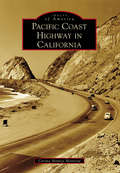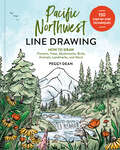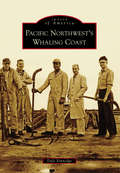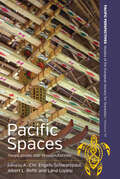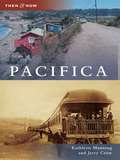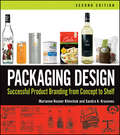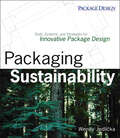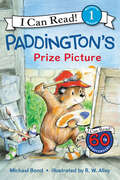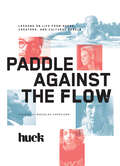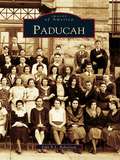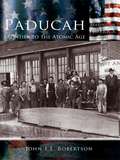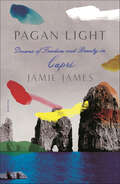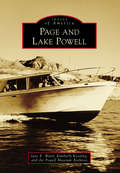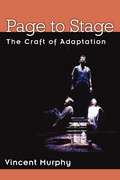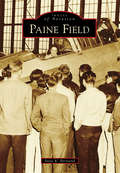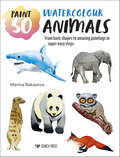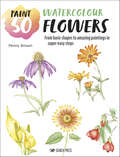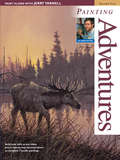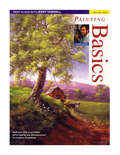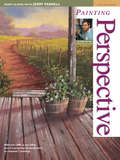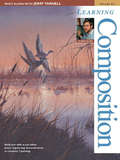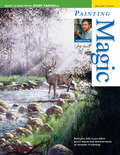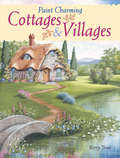- Table View
- List View
Pacific Coast Highway in California (Images of America)
by Carina Monica MontoyaMore commonly known as Pacific Coast Highway, State Route 1 ribbons along or near the Pacific Ocean from Northern California at Leggett in Mendocino down to Southern California at San Juan Capistrano in Orange County. Its construction began in 1913 and was done incrementally, largely because of funding issues, shortage of labor, legal challenges, deep canyons, steep mountains, solid rock, and unstable earth. A true modern marvel, its unique and extraordinary construction allows easy access to some of the country's most famous and historical places and picturesque sights. Thousands of pounds of dynamite were used to blast through granite, marble, and sandstone to build a highway following near or along the coastline. Among the 33 bridges along the route is the remarkable Bixby (Rainbow) Bridge at Big Sur. The highway wends its way through some of the most magnificent and scenic landscapes and historical places found between Ventura and Humboldt Counties, making it more than just a road. It is a destination.
Pacific Northwest Line Drawing: How to Draw Flowers, Trees, Mushrooms, Birds, Animals, Landmarks, and More
by Peggy DeanThis book of simple step-by-step line drawings from beloved art teacher Peggy Dean of The Pigeon Letters will deepen your appreciation for the wonders of the Pacific Northwest.Learn to draw 150 Pacific Northwest natural wonders (plus iconic landmarks) in just a few simple steps each! Rooted in love for the PNW, this no-skills-necessary how-to-draw book will encourage users to stop and notice the beauty that surrounds them. Here you&’ll learn the basics of line drawing as well as facts about the ecology, plants, wildlife, and landmarks of this amazing region. Inside you'll find:Native plants like salmonberries, sword ferns, and Pacific rhododendronMajestic trees like the Western red cedar and Douglas firMysterious mushrooms like the chanterelle and morelIconic animals like otters and orcasBucket-list birds like the Northern spotted owl and tufted puffinPopular landmarks like the Space Needle, Mount Rainier, and Crater LakeLine drawing is a meditative, easy-to-master art form featuring illustrative, doodle-like designs. Peggy, who has deep roots in the Pacific Northwest, teaches you how to start with the simplest doodles, building into more elaborate, delicate illustrations. These simple line drawings will allow you to branch out and have fun with your own personal style, as well as inspire you to add flourishes to other projects. Drawings are ordered from simple to advanced, and by category (flora, fauna, landmarks).If you enjoyed Ed Emberley as a child, you&’ll love this book of simple step-by-step line drawings with space to practice!
Pacific Northwest's Whaling Coast
by Dale VinnedgePacific Northwest waters from Alaska to Oregon lie between the Arctic whaling grounds and the home whaling ports of San Francisco and Honolulu. While the Pacific Northwest was not a whaling destination, whales in these rich grounds were pursued for many years as whale ships moved between the whalers' summer whaling grounds and southern home ports. After 1900, whaling in the north Pacific changed from sailing ships to modern, steam-powered iron ships and harpoon cannons. Land stations were built along southern Alaska, Vancouver Island in British Columbia, and Washington State. The new "killer" ships brought whales to these land stations for flensing and for rendering into oil, fertilizer, and other products. Most of these products were shipped to Seattle and San Francisco on steamers and factory ships at the end of the season. At the start of the season, supplies and workers were shipped up from Seattle to resupply and repopulate the stations.
Pacific Spaces: Translations and Transmutations (Pacific Perspectives: Studies of the European Society for Oceanists #10)
by Albert L. Refiti A.-Chr. Engels-Schwarzpaul, Lana LopesiDelving into Pacific spaces from a variety of disciplinary perspectives and interpretations, this book looks at how the anthropological and architectural can be connected. The contributors to this book – architectural practitioners, architectural and spatial design theorists, anthropologists and historians – show not only how new theoretical perspectives can arise out of comparing aspects specific to one discipline with their equivalents of another, but also demonstrate how a space of emergence is created for something that goes beyond both, enhancing both fields of potentialities.
Pacifica
by Kathleen Manning Jerry CrowPacifica and its coast, once envisioned as a string of resorts, casinos, and vacation cottages in place of artichoke fields, was overlooked after the failure of the Ocean Shore Railroad in 1920. Demand for reasonably priced housing revived the boom, and Pacifica was incorporated in 1957.
Package Design Workbook: The Art And Science Of Successful Packaging
by Steven Dupuis John SilvaThe Art and Science of Successful Packaging provides designers with a thoughtful packaging primer that covers the challenges of designing packaging for a competitive market in a very hardworking and relevant way. Package Design Workbook addresses all aspects of the creative process including choosing a package format, colors and materials, final finishes, and special considerations such as awkward objects and unique display considerations. This book breaks down the process of design in a much more comprehensive way than most books on the subject, which just analyze the final designs. This guide also offers case studies in the back half of the book with the text focusing on why specific colors, formats, type treatments, and finishes were chosen, and what the resulting effects were on the consumer and the client.
Packaging Design
by Marianne R. Klimchuk Sandra A. KrasovecThe fully updated single-source guide to creating successful packaging designs for consumer productsNow in full-color throughout, Packaging Design, Second Edition has been fully updated to secure its place as the most comprehensive resource of professional information for creating packaging designs that serve as the marketing vehicles for consumer products. Packed with practical guidance, step-by-step descriptions of the creative process, and all-important insights into the varying perspectives of the stakeholders, the design phases, and the production process, this book illuminates the business of packaging design like no other.Whether you're a designer, brand manager, or packaging manufacturer, the highly visual coverage in Packaging Design will be useful to you, as well as everyone else involved in the process of marketing consumer products. To address the most current packaging design objectives, this new edition offers:Fully updated coverage (35 percent new or updated) of the entire packaging design process, including the business of packaging design, terminology, design principles, the creative process, and pre-production and production issuesA new chapter that puts packaging design in the context of brand and business strategiesA new chapter on social responsibility and sustainabilityAll new case studies and examples that illustrate every phase of the packaging design processA history of packaging design covered in brief to provide a context and framework for today's businessUseful appendices on portfolio preparation for the student and the professional, along with general legal and regulatory issues and professional practice guidelines
Packaging Sustainability
by Wendy JedlickaHow to take the lead with sustainable packaging design solutions With initiatives like the Wal-Mart Scorecard in the U.S. and the E.U.'s Packaging Directive, delivering sustainable packaging is now an integral part of today's global competitive market. Written by experts from a wide variety of fields, here is a comprehensive, single source of actionable information that enables everyone involved in the design and development process to make smart, informed decisions, opening new possibilities for creating truly innovative solutions. Wendy Jedlicka, CPP (Roseville, MN) is President of Jedlicka Design Ltd. and a member of the faculty at Minneapolis College of Art and Design's groundbreaking Sustainable Design Certificate Program. A Certified Packaging Professional, she serves as Upper Midwest Chapter Chair (o2umw.org), as well as U.S. co-coordinator for the o2 Global Green Design Network (o2.org), and contributes frequently to Packaging Design magazine's "Sustainability Update" feature column.
Paddington's Prize Picture (I Can Read Level 1)
by Michael BondPaddington Bear has charmed readers of all ages for almost 60 years! Now part of the I Can Read line, Michael Bond’s classic character will delight beginning readers with his curious nature and nose for adventure. Paddington discovers a love of painting when Mr. Gruber shows him just how fun it can be. But he’s not the only one—Mr. Brown has an artistic streak, too. So when a painting contest comes to town, the winning picture is a surprise to all. Because when Paddington is involved, the ordinary turns extraordinary! Paddington’s Prize Picture is a Level One I Can Read book, which means it’s perfect for children learning to sound out words and sentences.
Paddle Against the Flow: Lessons on Life from Doers, Creators, and Cultural Rebels
by Huck MagazineNas on language, Cat Power on looking inward, Spike Jonze on loving what you do, and Kim Gordon on feeling the flow. These are just a few of the indie stars and surprising insights collected in this gorgeous book by Huck magazine. Since launching in 2006, Huck has been at the vanguard of London's thriving independent publishing scene and has grown into an internationally distributed bi-monthly, with editions available on newsstands in 20 countries worldwide. Bringing together the best insights from over 60 of the most inspiring people Huck has spoken to over the years—along with exclusive photography and art that has come to embody Huck's distinct aesthetic—this book presents a diverse range of truths, creative wisdom, and life lessons from those who paddle against the flow.
Paducah: Frontier To The Atomic Age (Images of America)
by John E.L. RobertsonLocated in the westernmost area of Kentucky known as the Jackson Purchase, Paducah has witnessed tremendous change since its beginnings in the early 19th century. Founded by William Clark of the Lewis and Clark expedition, Paducah officially became a town in 1830 and gained the McCracken County seat a year later. Thanks to the area's river resources, the arrival of the New Orleans and Ohio Railroads, and the installment of the telegraph line, Paducah experienced considerable growth, despite the occurrence of natural disasters, before the Civil War when Grant seized the town. Since then, Paducah has become a bustling center of industry, education, and tourism.Images of America: Paducah contains a multitude of photographs that provide a glimpse into the city's period of growth, featuring the contributions of the rivers, the development of accredited Kentucky community colleges, and the unique events, such as the annual quilt show, which attracts 30,000 visitors.
Paducah: Frontier to the Atomic Age
by John E.L. RobertsonOne of the last frontier towns east of the Mississippi, Paducah took center stage in the drama of an expanding United States despite a late start and a penchant for independence and self reliance. The Kentucky river city played no small part in the rise of river commerce and its successor, the railroads. From river packets to enriched uranium, its history is marked by victory over disastrous floods and a headlong rush toward a future embracing new technology.Paducah: Frontier to the Atomic Age tells the story of a community torn apart from the start between Chickasaw and American claims, then Confederate and Union invasions. Exploring the expanding city streets and the ever-busy waterfront, readers will meet natives Quintus Quincy Quigley, chronicler of events on the eve of the Civil War; the "Dean," Dr. Robert Gordon Matheson, who revolutionized two-year colleges; and Mrs. Houston "Dolly" McNutt, among the first female mayors in Kentucky.This unique volume also recounts the story of the city's central role in nineteenth-century history, thanks to its strategic location at the mouth of the Tennessee River on the Ohio. At that time, the Civil War struggle for control of border states tested Paducah's loyalty even while the rest of Kentucky fought to remain neutral, and Reconstruction brought new challenges in race relations to a region deeply divided by the ghosts of slavery. In the twentieth century, the city developed tremendously with the advent of new industry and was the adopted home of President Truman's pioneering Vice President Alben Barkley, among the most effective and groundbreaking statesmen to fill that office.
Pagan Light: Dreams of Freedom and Beauty in Capri
by Jamie JamesA New York Times Book Review Editors' Choice"Pagan Light is mesmerizing. Every detail is compelling. I felt I was reading a family history of a family far more interesting than mine." --Edmund White, author of Our Young ManA rich, intimate embrace of Capri, which was a magnet for artistic renegades and a place of erotic refugeIsolated and arrestingly beautiful, the island of Capri has been a refuge for renegade artists and writers fleeing the strictures of conventional society from the time of Augustus, who bought the island in 29 BC after defeating Antony and Cleopatra, to the early twentieth century, when the poet and novelist Jacques d’Adelswärd-Fersen was in exile there after being charged with corrupting minors, to the 1960s, when Truman Capote spent time on the island. We also meet the Marquis de Sade, Goethe, Mark Twain, Oscar Wilde, Compton Mackenzie, Rilke, Lenin, and Gorky, among other astonishingly vivid characters. Grounded in a deep intimacy with Capri and full of captivating anecdotes, Jamie James’s Pagan Light tells how a tiny island served as a wildly permissive haven for people—queer, criminal, sick, marginalized, and simply crazy—who had nowhere else to go.
Pagan Virtue in a Christian World: Sigismondo Malatesta and the Italian Renaissance
by Anthony F. D'EliaIn 1462 Pope Pius II performed the only reverse canonization in history, damning a living man to an afterlife of torment. What had Sigismondo Malatesta, Lord of Rimini and a patron of the arts, done to merit this fate? Anthony D'Elia shows how the recovery of classical literature and art during the Italian Renaissance led to a revival of paganism.
Page and Lake Powell
by Kimberly Keisling Powell Museum Archives Jane E. WardThe people who descended on the remote northern Arizona wilderness in the early 1950s to build Glen Canyon Dam and the town of Page were true pioneers. They arrived to find Glen Canyon, a sandy, desolate hilltop with walls over 700 feet deep that had been part of the vast Navajo reservation, and an incredibly challenging way of life. The first blast necessary for site excavation at Glen Canyon Dam was triggered on October 15, 1957, when Pres. Dwight D. Eisenhower pressed a key setting off the explosion from an office in Washington, DC. Almost 10 years later, construction was completed on the nation's second-highest concrete dam, harnessing the waters of the Colorado River and forever changing the history of the local area and the West. Today, over three million annual visitors enjoy the diverse and awe-inspiring landscape surrounding Page and Lake Powell.
Page to Stage: The Craft of Adaptation
by Vincent MurphyAt last, for those who adapt literature into scripts, a how-to book that illuminates the process of creating a stageworthy play. Page to Stage describes the essential steps for constructing adaptations for any theatrical venue, from the college classroom to a professionally produced production. Acclaimed director Vincent Murphy offers students in theater, literary studies, and creative writing a clear and easy-to-use guidebook on adaptation. Its step-by-step process will be valuable to professional theater artists as well, and for script writers in any medium. Murphy defines six essential building blocks and strategies for a successful adaptation, including theme, dialogue, character, imagery, storyline, and action. Exercises at the end of each chapter lead readers through the transformation process, from choosing their material to creating their own adaptations. The book provides case studies of successful adaptations, including The Grapes of Wrath (adaptation by Frank Galati) and the author's own adaptations of stories by Samuel Beckett and John Barth. Also included is practical information on building collaborative relationships, acquiring rights, and getting your adaptation produced.
Paine Field (Images of Aviation)
by Steve K. BertrandPaine Field was named in honor of hometown hero Topliff Olin Paine, an Army Air Corps pilot during World War I. Located 6 miles south of Everett and 20 miles north of Seattle, Paine Field-- known as Snohomish County Airport--got its start as a WPA project in the 1930s. Situated on 1,000 acres, this airport was shaped by numerous events, such as World War II, the Korean War, and the arrival of Boeing, as well as social, political, and environmental issues that continue to influence its destiny. Throughout its 77-year history, Paine Field has continued to evolve into a thriving aviation community. At the heart of its success has been the key role of general aviation. A rags-to-riches story, Paine Field has grown from a small regional airport into an aeronautical complex that garners worldwide attention.
Paint 50: Watercolour Animals
by Marina BakasovaLearn to paint 50 vibrant watercolour animals in seven simple stages, with award-winning artist Marina Bakasova.Paint 50 Watercolour Animals is the first title in a new beginner-friendly 'how-to-paint' series. This book will focus on a range of animals, from popular pets to wild creatures; from fun flamingos and doting dogs to mischievous monkeys. Over the course of 50 simple watercolour projects, this title will teach you how to paint! Each project can be completed in just seven simple steps from initial line drawing to finished creation, using a small selection of colours and a handful of easy-to-follow watercolour techniques.Whether you want to create a hand-painted card, decorate your wall or maybe you simply want to learn the relaxing art of painting with watercolours, with 50 cute motifs to choose from, you’ll easily find something to inspire you.No prior knowledge of watercolour techniques needed – This book contains a short list of tools and materials needed to get started and a clear and informative guide to the basic techniques needed to paint this varied collection of animals.No drawing skills required – The line drawings are provided at full size, ready to copy or trace – and all the information on how to do so is included. The line drawings are also available to download for free from Bookmarked (www.bookmarkedhub.com).Suitable for artists of all levels – Marina’s clear instructions guide the reader from start to finish in a way that makes it easy for anyone to pick up a brush and learn how to paint in her loose, characterful style.
Paint 50: Watercolour Flowers
by Penny BrownLearn to paint 50 vibrant watercolour flowers in seven simple stages, with award-winning artist Penny Brown.Paint 50: Watercolour Flowers is the second title in a new beginner-friendly 'how-to-paint' series, following the same step-by-step formula as the mega-selling How to Draw series. This book focuses on a range of flowers, from rambling roses to elaborate orchids. This clear, large-format book covers classic cottage garden favourites to exciting exotics, ensuring that you're sure to find your favourite.The book will teach you how to paint over the course of 50 simple watercolour projects. Each can be completed in just 7 simple steps from initial line drawing to finished creation, using a small selection of colours and a handful of easy-to-follow watercolour techniques. Whether you want to create a hand-painted card, decorate your wall or maybe you simply want to learn the relaxing art of painting with watercolours, with 50 motifs to choose from, you’ll easily find something to inspire you.No prior knowledge of watercolour techniques needed –This book contains a short list of tools and materials needed to get started and a clear and informative guide to the basic techniques needed to paint this varied collection of flowers.No drawing skills required – The line drawings are provided at full size, ready to copy or trace – and all the information on how to do so is also included. The line drawings are also available to download for free from Bookmarked Hub.Suitable for artists of all levels – With a laser-focus on just the essential colours and techniques, Penny Brown's years of artistic and teaching experience cut through to give you exactly what you need to succeed.
Paint Along with Jerry Yarnell Volume Five - Painting Adventures (Paint Along with Jerry Yarnell)
by Jerry YarnellLove to paint? Want to learn? Then let's get started!The adventure begins the moment you pick up a brush. Let Jerry Yarnell show you how to make the most of it! In Painting Adventures - the fifth volume of his popular painting series - you'll learn how to create attractive landscapes with skill and confidence.Drawing upon more than thirty years of painting and teaching experience, Jerry provides you with dozens of exciting new challenges and unexpected surprises, along with seven gorgeous step-by-step projects. You'll learn how to paint night scenes, clouds, people and wildlife, plus realistic fur, feathers and hair. It's all the insight and instruction you need to paint your most exciting landscapes yet!
Paint Along with Jerry Yarnell Volume One - Painting Basics (Paint Along with Jerry Yarnell)
by Jerry YarnellYou can transform a blank canvas into a spectacular landscape even if you've never painted before. Jerry Yarnell-the master of popular painting-will show you how with his successful step-by-step painting techniques. You'll learn to create beautiful art, building your skills and having fun every time you approach the canvas. The lessons inside will enable you to produce 10 complete paintings and provide you with detailed information on subjects such as color mixing, applications, composition, value studies, depth perception and much more. Whether you're a beginning, intermediate or advanced painter, Jerry Yarnell's 28 years of art experience will inspire and enrich your painting journey-a lifelong learning process full of discovery and wonder.
Paint Along with Jerry Yarnell Volume Seven - Painting Perspective (Paint Along with Jerry Yarnell)
by Jerry YarnellLove to paint? Want to learn? Then let's get started!With Jerry Yarnell at your side, it's easy to make your artistic dreams come true. In this fun and easy guide, he provides tips and tricks for mastering one- and two-point perspective - the keys to adding realistic buildings and other man-made objects to your paintings.You'll also find complete step-by-step instruction for painting seven idyllic landscapes, plus proven techniques for painting everything from windmills and rural houses to adobe buildings and old weathered wood.Whether you're ready to start your very first painting or add new subjects to your work, this book is the only key you need to unlock your creative potential. Put yourself on the road to artistic success today!
Paint Along with Jerry Yarnell Volume Six - Learning Composition (Paint Along with Jerry Yarnell)
by Jerry YarnellLove to paint? Want to learn? Then let's get started!In Learning Composition, Jerry Yarnell helps you reach new levels of artistic expertise. Inside, he provides insightful, easy-to-follow instructions for building effective compositions - the kind of dynamic designs that will make your paintings pop!Drawing upon more than thirty years of painting and teaching experience, Jerry details three different types of composition, the principles of good design, the proper use of negative space and more. Seven gorgeous, step-by-step painting projects illustrate each concept in action.From lovely log cabins and mountain peaks to rocky roads and windmills, Jerry makes it easy to increase your skills and confidence. Grab your brush and paints and get started today!
Paint Along with Jerry Yarnell Volume Three - Painting Magic (Paint Along with Jerry Yarnell)
by Jerry YarnellLove to paint? Want to learn? Then grab your paints and brushes and get started!Learn all the tricks and techniques you need to perform "magic" with paint! In Painting Magic, the third volume of his popular painting series, Jerry Yarnell helps you move beyond the basics and begin tackling more involved paintings.You'll find ten beautiful step-by-step projects, each designed to provide a new set of artistic challenges that help you to master composition, design, perspective, value, color and atmosphere.Paint gorgeous mountain cliffs, weathered adobe buildings, mist-shrouded forests, a rustic farm, a covered bridge and more! Jerry makes it easy for you to improve, expand your repertoire or skills and build true artistic confidence.
Paint Charming Cottages & Villages
by Kerry TroutCapture the Charm of Cottage and Village ScenesBring the storybook cottages and towns of your dreams to life. Ten step-by-step projects show you how to paint a variety of architectural styles from a Victorian "gingerbread" house, to an English Tudor cottage, to a Cape Cod and a classic farmhouse. Two nostalgic village scenes take you back to simpler days of main streets lined with merchants, dress shops and tearooms.Dozens of quick mini-demonstrations show you how to embellish your scenes with quaint details, including porch swings, lace curtains, fountains, old-time lampposts, picket fences and quilts fluttering on a clothesline. You'll also learn how to add the seasonal touches of fall foliage, spring flowers and winter snows.Each project is painted with acrylic paints. Full-color photos, traceable patterns, color swatches, detailed materials lists and a techniques section make each painting easy to do. Use your paintbrush and these projects to create your own quaint getaway cottages today!
